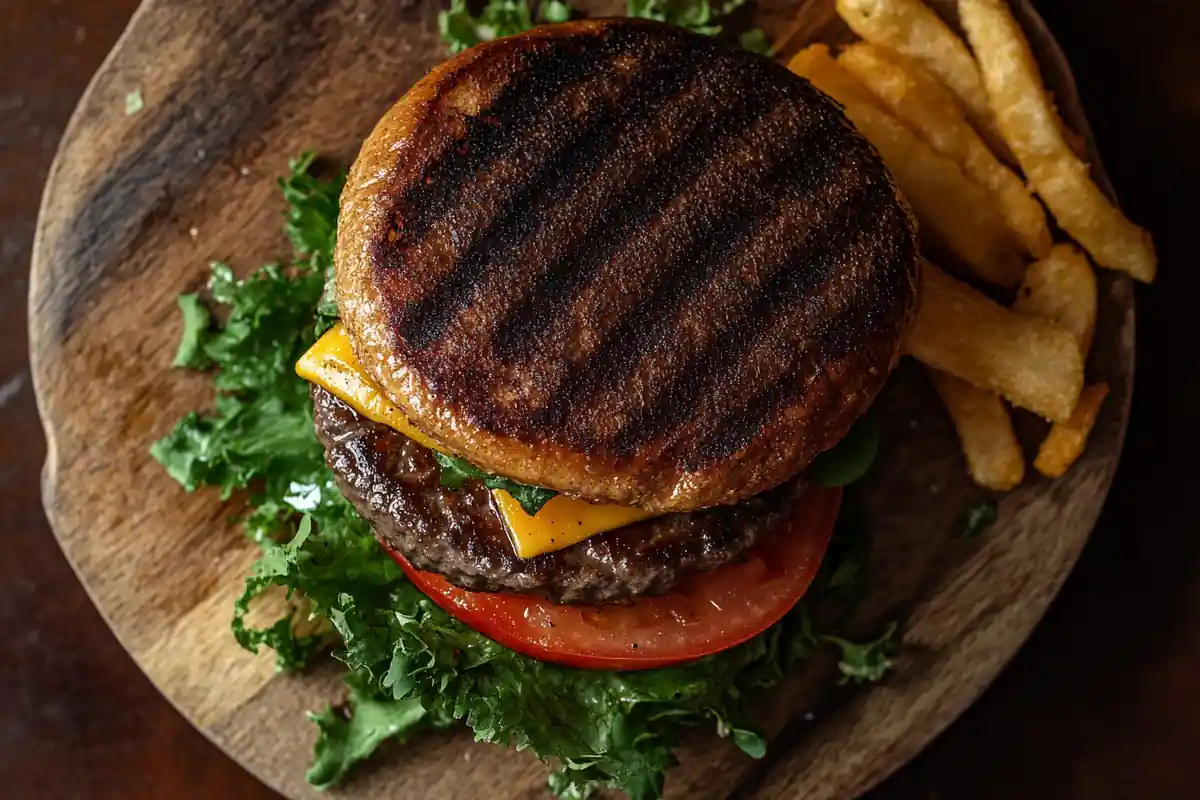Discover if you can cook a hamburger in a breakfast sandwich maker. This guide explores its feasibility, methods, and safety.
Can you cook a hamburger in a breakfast sandwich maker? This question is common among home cooks seeking quick meal solutions. Breakfast sandwich makers are designed for eggs and breakfast meats. However, their compact size and heating elements might seem suitable for small hamburger patties. Therefore, let’s explore if it’s possible. Understanding the device’s capabilities is key.
Specifically, these devices have circular cooking plates and heating elements. They heat bread and small items well. However, cooking a hamburger needs proper temperature control and even cooking. According to the USDA, specific temperatures are needed for safe cooking. Therefore, we need to see if breakfast sandwich makers meet those requirements. Mess is also a factor. The Food Safety and Inspection Service website and the FDA’s safe food handling guide offer more information. The main challenge is cooking a hamburger patty safely without creating a mess.
Another thing to consider is size. Typically, breakfast sandwich makers are designed for smaller items. A standard hamburger patty might not fit well. This can cause uneven cooking and spillage. The meat type also matters. Lean meat cooks differently than fattier meat. Patty thickness also affects cooking time. Consequently, several factors need consideration before attempting this. Nonetheless, let’s examine methods and safety precautions.
Understanding Your Breakfast Sandwich Maker
Before cooking a hamburger, you must understand your breakfast sandwich maker. Firstly, they have non-stick cooking plates. Secondly, they have heating elements on both sides. Thirdly, they have a closing mechanism. These features are good for eggs, cheese, and pre-cooked meats.
However, heat distribution isn’t always even. Therefore, some spots are hotter than others. Additionally, many models lack temperature controls, making precise cooking difficult. Overall, they’re for quick, light cooking, not raw ground beef. Nevertheless, proper technique can yield decent results. Moving forward, let’s explore essential factors.
Key Features and Limitations
-
Non-Stick Surfaces: Most have non-stick surfaces, reducing sticking.
-
Heating Plates: Dual plates are used for the cooktop and bottom.
-
Fixed Temperature: Many operate at a fixed temperature.
-
Size Constraints: Small cooking areas limit patty size.
-
Lack of Drip Tray: This can make cleaning messy.
-
Limited Height: Thick patties are difficult to cook.
-
No Built-in Timer: Requires close monitoring.
Despite these limitations, people want to adopt the device. Therefore, in the next section, we’ll cover prep methods.
Preparing to Cook
Before starting, proper preparation is key. Firstly, choose the right meat. Secondly, shape the patty correctly. Thirdly, ensure your breakfast sandwich maker is clean. These steps improve results and safety. Specifically, proper ingredients and techniques are crucial. Therefore, a detailed approach is necessary.
Choosing the Right Meat
The type of ground beef affects cooking. Firstly, consider the fat content. Secondly, think about the grind size. Thirdly, consider the flavor. 80/20 or 85/15 fat content works well for flavor. If you prefer leaner, use 90/10. Medium or fine grind is recommended for texture. Also, use fresh meat if possible.
Shaping the Hamburger Patty
Shaping correctly is important. Firstly, ensure it’s not too thick. Secondly, make it fit the breakfast sandwich maker. Thirdly, ensure it is flat. A 2 to 3-ounce patty is ideal. Flatten the patty for even cooking. Use a patty press if you have one. Make sure it does not extend beyond the cooking area. Therefore, shaping is important.
Prepping the Breakfast Sandwich Maker
Before cooking, prep your breakfast sandwich maker. Firstly, wipe the cooking plates with a damp cloth. Secondly, ensure it’s dry. Thirdly, preheat it as instructed. This helps cook the hamburger evenly and prevents sticking. Additionally, check the machine for debris. Therefore, this step should not be skipped.
In the next division, we’ll explore cooking methods and techniques.
Cooking in the Sandwich Maker

Cooking a hamburger requires careful attention. Firstly, place the patty properly. Secondly, monitor the cooking time. Thirdly, ensure the hamburger reaches a safe temperature. Therefore, it’s not as simple as just putting meat in the machine. Specifically, it requires managing heat and time.
Placing the Patty
Once preheated, place the hamburger patty. Firstly, open the device. Secondly, center the patty on the bottom plate. Thirdly, ensure it’s not touching the edges. If your device has a sticky upper plate, consider using a cooking spray. Spray the bottom as well, while the plates are cold. Therefore, this promotes even cooking. Furthermore, proper placement prevents uneven cooking. Subsequently, close the lid carefully.
Monitoring Cooking Time
Monitoring cooking time is crucial for a safe hamburger. Firstly, start with 2-3 minutes. Secondly, check the meat’s progress. Thirdly, use a meat thermometer. Typically, a hamburger needs to reach 160°F (71°C) internally. Also, if raw, continue cooking. Test the temperature at the thickest part. Additionally, cooking times can vary. Therefore, keep monitoring. Undeniably, reaching a safe temperature is essential.
Managing Grease
One problem is grease management. Firstly, breakfast sandwich makers lack a drip tray. Secondly, this can cause spillage. Thirdly, this is messy. Use lean meat to minimize this. Also, don’t make the patty too thick. You could place paper towels around it. Furthermore, try not to overfill. Therefore, this helps control the mess. Specifically, avoid difficult cleaning.
Moving forward, let’s discuss safety.
Safety Precautions
Safety is essential when cooking hamburgers. Firstly, follow USDA guidelines. Secondly, always use a meat thermometer. Thirdly, never leave the device unattended. Therefore, precautions are vital. Specifically, raw meat and heat require careful handling.
Internal Temperature
Ensuring the hamburger reaches a safe temperature is crucial. Firstly, use a meat thermometer. Secondly, aim for at least 160°F (71°C). Thirdly, check the thickest part. Also, undercooked meat can cause illness. Therefore, thorough cooking is essential. Furthermore, don’t guess doneness. Undoubtedly, this is most important.
Preventing Overheating
Overheating can damage your device and create hazards. Firstly, follow the manufacturer’s instructions. Secondly, don’t leave it unattended. Thirdly, don’t cook with the lid open. If the device seems too hot, unplug it and let it cool. Additionally, do not use damaged devices. Specifically, heat damage is problematic. Therefore, monitor the temperature.
Avoiding Cross-Contamination
Cross-contamination is a concern. Firstly, wash your hands after handling raw meat. Secondly, use clean utensils. Thirdly, clean the breakfast sandwich maker after use. Also, this prevents the spread of bacteria. Use separate cutting boards and utensils. Consequently, prevention is key for food safety. Undeniably, it’s essential.
In the following section, let’s discuss flavor enhancement.
Adding Flavor
Although the breakfast sandwich maker isn’t traditional for burgers, you can still enhance flavor. Firstly, use seasoning. Secondly, add spices to the ground beef. Thirdly, consider simple additions. Therefore, the cooking method doesn’t mean bland burgers. Specifically, seasoning makes a big difference.
Seasoning the Meat
Seasoning improves flavor. Firstly, use salt and pepper. Secondly, add garlic or onion powder. Thirdly, consider other herbs. Mix seasoning into the ground beef before shaping. Furthermore, let the meat sit for a few minutes before cooking. Specifically, this helps the flavors meld. Therefore, this step enhances the overall taste.
Simple Additions
Apart from spices, you can add simple ingredients. Firstly, consider finely chopped onions. Secondly, add Worcestershire sauce. Thirdly, include cheese inside. Some like breadcrumbs for moisture. However, additions need to be small to fit. Furthermore, these help to make your burger more flavorful. Therefore, experiment. Indeed, small steps can make a difference.
Transitioning to the next portion, let’s cover cleanup.
Cleaning Up After Cooking

Cleaning up can be messy. Firstly, clean promptly. Secondly, remove all grease and residue. Thirdly, follow the manufacturer’s guidelines. Therefore, cleaning is important for safety and maintenance. Specifically, neglecting cleaning can cause problems.
Prompt Cleaning
Prompt cleaning is essential. Firstly, unplug and let the device cool. Secondly, wipe the cooking plates with a damp cloth. Thirdly, remove stuck-on food. Use a non-abrasive sponge or cloth to avoid damage. Do not submerge the device in water. Specifically, this can cause damage. Therefore, prompt cleaning is key.
Grease Removal
Removing grease is important for hygiene. Firstly, wipe excess grease with paper towels. Secondly, use mild detergent and warm water. Thirdly, clean all parts. Pay extra attention around the plates. Use a soft brush for stubborn residue. Therefore, ensure all grease is gone. Consequently, this ensures the device is ready for the next use.
Proceeding, let’s look at the pros and cons of using the device.
Pros and Cons
Cooking hamburgers in a breakfast sandwich maker has advantages and disadvantages. Firstly, it’s quick. Secondly, it’s convenient. Thirdly, it’s limited by the device. Therefore, let’s weigh them. Specifically, evaluate benefits and drawbacks to see if it’s suitable.
Pros
-
Speed: Heats up quickly for rapid cooking.
-
Convenience: Compact and easy to use.
-
Less Mess: Reduced splatter compared to pan-frying.
-
Small Portions: Ideal for single servings.
-
Even Cooking: Dual plates promote even cooking.
Cons
-
Small Size: Patties must be small, limiting size.
-
Uneven Cooking: Heat isn’t always uniform.
-
Limited Temperature Control: No precise settings.
-
No Grease Tray: Messy and requires more cleanup.
-
Safety Concerns: Difficult to cook to a safe temperature.
In the following part, let’s summarize the best practices.
Best Practices
If you decide to cook a hamburger in a breakfast sandwich maker, best practices are vital. Firstly, follow safe food handling guidelines. Secondly, use the right meat and patty size. Thirdly, monitor the cooking time. Therefore, planning ensures the best and safest results.
Use the Right Meat and Patty Size
Firstly, choose lean ground beef. Secondly, make small, thin patties that fit. Avoid overly thick patties to prevent uneven cooking. Furthermore, use fresh meat. Specifically, these factors make a difference in the overall result.
Monitor Cooking Time
Secondly, monitor cooking time closely. Firstly, start with 2 to 3 minutes. Secondly, check the internal temperature. Thirdly, cook until it reaches 160°F (71°C). Also, don’t overcook. Furthermore, monitoring temperature is important for safety. Therefore, use a meat thermometer.
Prioritize Safety
Lastly, prioritize safety. Firstly, follow all food safety guidelines. Secondly, use clean utensils. Thirdly, clean the device after use. Also, do not leave the device unattended, and avoid cross-contamination. Therefore, these practices are essential. Indeed, it helps avoid foodborne illnesses.
Continuing, let’s explore some frequently asked questions.
Frequently Asked Questions (FAQs)
Many have questions about cooking hamburgers in a breakfast sandwich maker. Therefore, this section will address the most common ones. Firstly, we’ll cover burgers. Secondly, other meats. Thirdly, common questions about these devices.
Can you cook burgers in a sandwich maker?
Yes, Can you cook a hamburger in a breakfast sandwich maker? Specifically, use small patties. Also, monitor cooking time and temperature. Furthermore, results may differ from traditional cooking. Therefore, it is possible under specific conditions.
Can you cook meat in a sandwich maker?
Yes, but be careful. Specifically, smaller, pre-cooked meats like ham work well. Raw meat needs monitoring to ensure it’s cooked. Some meats are greasy. Therefore, follow safe cooking guidelines.
Can you make scrambled eggs in a sandwich maker?
Yes, it’s a common use. Specifically, use a bit of oil to prevent sticking. Also, pour the egg mixture into the cooking area and cook until set. Therefore, they are easy to prepare this way.
Can you put raw bacon in a breakfast sandwich maker?
Yes, but ensure it’s cooked through. Specifically, cook until crispy. Raw bacon needs enough time to reach a safe temperature. Bacon fat can make a mess. Therefore, monitoring is important.
In the next section, we’ll conclude.
Conclusion: Can you cook a hamburger in a breakfast sandwich maker?
In conclusion, can you cook a hamburger in a breakfast sandwich maker? Yes, with some limitations. Firstly, you need small, thin patties. Secondly, monitor cooking time and temperature. Thirdly, be aware of potential messes. Therefore, this method isn’t for everyone. Specifically, it’s quick for small servings. However, you must follow safety precautions. Ultimately, understand its limitations. Finally, always put safety first.

